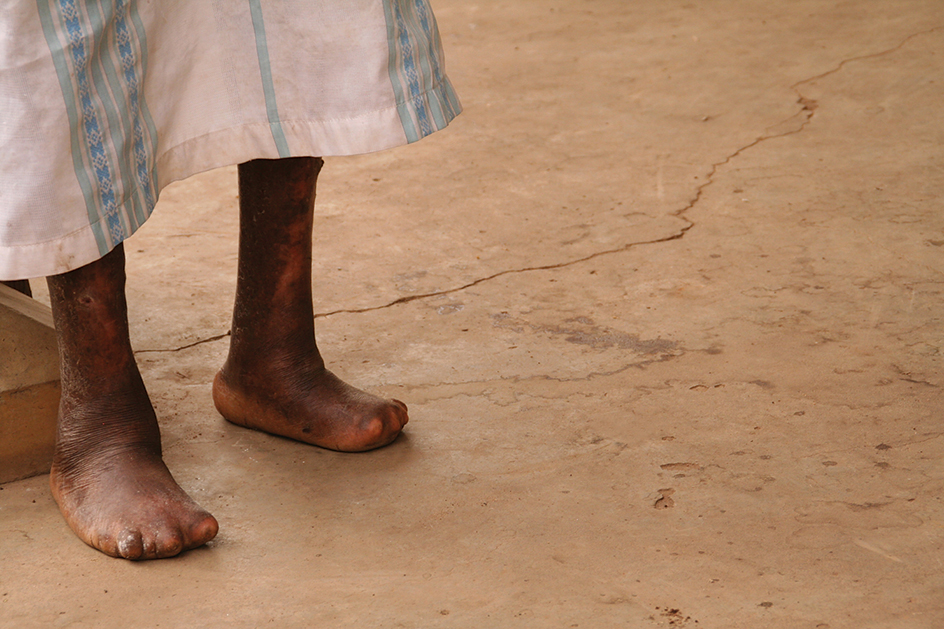Leprosy, also called Hansen’s disease, is a chronic infectious disease. It primarily affects the skin; the mucous membranes, especially those in the nose; and the peripheral nervous system, which includes nerves that connect the spinal cord to the muscles. In advanced cases of the disease, the eyes, liver, spleen, muscles, and bone marrow can also be affected. Leprosy is not usually fatal. However, patients with untreated or neglected infections may develop extreme deformities of the hands and feet.

Through the years, people with leprosy have been the victims of fear and prejudice, largely because of the deformities associated with the disease. In many societies, people with leprosy have been made outcasts from their communities.
Causes.
Leprosy results from infection by a rod-shaped bacterium called Mycobacterium leprae, sometimes known as Hansen’s bacillus. The Norwegian physician Gerhard H. Armauer Hansen first observed M. leprae bacteria in tissue specimens from leprosy patients in 1873. The following year, he proposed that the bacteria caused leprosy.
M. leprae infection occurs primarily in human beings. But the bacteria also have been found in armadillos, chimpanzees, and mangabey monkeys. Most evidence suggests that people become infected by inhaling the bacteria. However, some cases have reportedly resulted from skin-to-skin contact.
Symptoms.
Most people who are exposed to M. leprae resist infection and develop immunity after this exposure. Only a few actually develop the disease. Symptoms of leprosy typically appear three to five years after infection.
The chief symptoms of leprosy include white or reddish patches of skin, called skin lesions; the loss of feeling in the skin lesions; and thickened nerves. The skin may also thicken, and dark nodules (lumps) may appear on many parts of the body. If the disease is not treated, nerves can become severely damaged, causing weakness in the hands and feet. As a result, the fingers and toes may curl inward. If M. leprae enter the eyes, a painful inflammation called iritis can occur. In severe cases, the bacteria can cause blindness.
There are two main forms of leprosy: (1) tuberculoid and (2) lepromatous. Most patients with the tuberculoid form have only one or a few lesions with few, if any, M. leprae detectable in the tissue. Most patients with the lepromatous form have multiple lesions containing billions of bacteria per gram of tissue.
Treatment.
No effective, reliable vaccine to prevent leprosy has been developed. However, certain drugs can halt the progression of leprosy and can rapidly make the patient noninfectious. The sulfa drug dapsone has served as the chief medicine used to treat leprosy since the late 1940’s. However, by the early 1980’s, an alarming number of leprosy cases resistant to dapsone therapy had occurred.
To combat the dapsone-resistant bacteria, physicians now treat patients with combinations of two or three drugs. Patients with few lesions and few bacteria per lesion are treated for six months with both dapsone and the antibiotic rifampin. Patients who have many lesions or many bacteria per lesion are treated for two years with dapsone, rifampin, and another drug, clofazimine.
More than 11/2 billion people live in areas where leprosy is endemic (regularly found). Consequently, in addition to treatment of individual cases, public health measures are needed to combat the disease. For centuries, public health programs consisted of simply isolating patients and confining them to hospitals called leprosariums. This approach probably had little effect on the spread of the disease and did little good for the patient. It also did nothing to remove the fear and prejudice surrounding leprosy, which still hinder relief efforts in many parts of the world today.

Modern control programs have a twofold emphasis. They stress (1) community-based screening to detect cases of leprosy and (2) educating the community about the disease. Early detection and treatment can halt transmission of M. leprae in the community and can greatly reduce development of the disabilities associated with the disease. As a result, many screening programs include the medical examination of everyone in a school or community and drug therapy for all who are infected. Education of the community concentrates on reducing the fear of leprosy and encouraging infected individuals to seek treatment.
History.
Historians do not know where or when leprosy originated. The word leprosy appears in the Bible but probably refers to a variety of skin diseases, and not to leprosy alone. The first accurate description of leprosy appears around A.D. 300 in copies of writings by the Indian physician Sushruta, who lived almost 1,000 years earlier.
Leprosy entered Europe in the 300’s B.C. Some historians think it may have been introduced by the troops of the Macedonian military leader Alexander the Great, returning from India. Others think that enslaved people carried the disease when they were brought from India to Egypt. Leprosy spread slowly through the Mediterranean and then to the rest of Europe.
Leprosy reached epidemic proportions in western Europe in the A.D. 1100’s and 1200’s. It then gradually disappeared from Europe as living conditions and nutrition improved there. However, the disease persisted in Norway until the late 1800’s. In the Western Hemisphere, leprosy was unknown until the arrival of European explorers and settlers.
Today, leprosy afflicts 5 million to 6 million people worldwide. It is endemic in tropical or subtropical regions, including Africa, Central and South America, India, and Southeast Asia. Small pockets of the disease can also be found in southern Europe. In the United States, fewer than 300 new cases of leprosy appear annually. Most such cases of leprosy occur among immigrants from areas where the disease is endemic.
See also Damien, Father; Thalidomide.
